Plant This: Datura shuns the day, shines at dusk
If you brave the West Nile-carrying mosquitoes at dusk, you can enjoy the unfurling of datura’s lightly scented trumpets. Under a full moon last evening, I took these images of one of my datura (Datura wrightii) in full, moon-like bloom.
I like the curved “hooks” on the edges of the flowers, and their pleated appearance. The foliage is coarse and rangy, not really much to look at, but the leaves do have a faint white edge, which is nice.
The buds are long, about 6 to 8 inches, and they fatten up for a day or two before unfurling for one night’s glory.
They close by mid-morning the next day.
The seedpods are spiky and egg-shaped, with a leafy collar. Weird, aren’t they? Remember, all parts of this plant are poisonous. But it’s a deadly beauty.
Note: My Plant This posts are written primarily for gardeners in central Texas. The plants I recommend are ones I’ve grown myself and have direct experience with. I wish I could provide more information about how these plants might perform in other parts of the country, but gardening knowledge is local. Consider checking your local online gardening forums to see if a particular plant might work in your region.
All material © 2006-2012 by Pam Penick for Digging. Unauthorized reproduction prohibited.


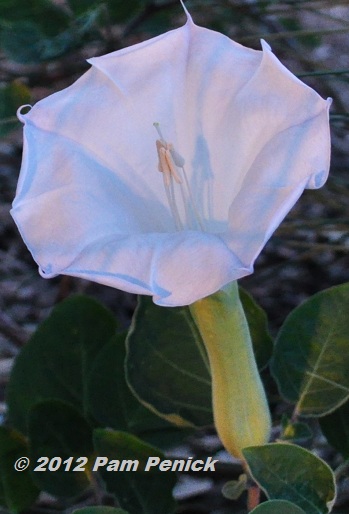
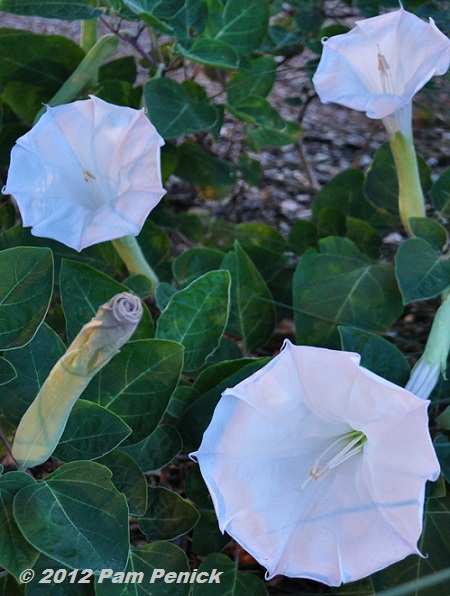
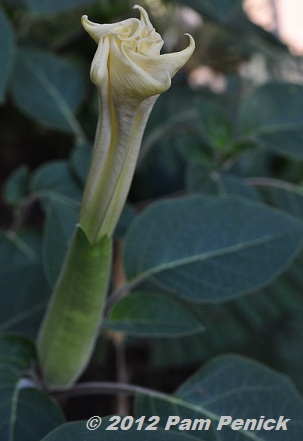
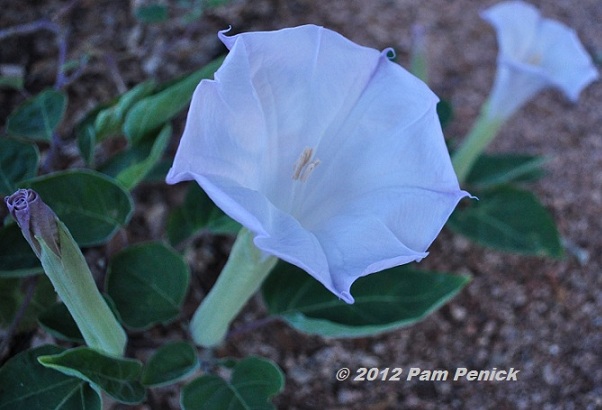
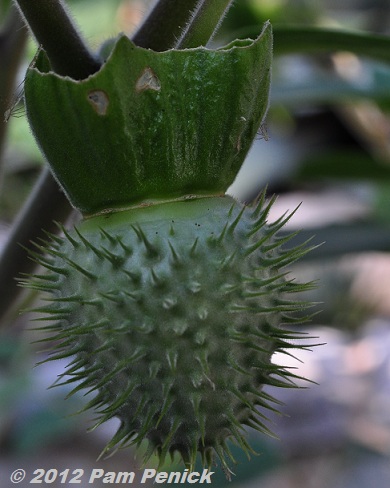
I have these beauties blooming in the garden too. I love to peek out at them to see if the big moths are drawn to them. Often I see them hovering over those blooms. The plants are quite drought tolerant. I found out this summer that rabbits will eat the leaves though. I didn’t think anything bothered them.
Oh, those pesky wabbits! —Pam
Nightshade family, very dangerous. Love its fragrance too!
Me too, Darla. And it’s fun to have a little danger in the garden (so long as you don’t have a nibbler in the family). —Pam
Those are so beautiful in the early evening glow and you’ve captured it just right. Mine are not blooming yet, just another interesting year for gardening.
I’ve been staying in a lot more since one of the West Nile deaths was in a nearby neighborhood. Summer evenings are usually an important gardening time for me so things have slowed down here quite a bit.
I’m sorry the risk of West Nile has restricted your ability to be outdoors in the evening right now, Shirley. That’s one of our best times of day to enjoy the garden in this climate, isn’t it? —Pam
Your Datura are so beautiful. I might try growing a few next year. Are yours drought-tolerant? I wonder how they will do in our dry summers. My three Brugs are water hogs.
Alison, they are quite drought-tolerant, although they appreciate a nice drink from time to time. —Pam
I’ve heard these smell really good. I’m not out in the evening normally, though, so I would probably miss all the flowers! Very pretty, though!
If you’re out in the early morning, Indie, you’ll still be able to enjoy them. Mine stay open until about 9 am. —Pam
I grew these very successfully one year, then I realized they were poisonous and I had a young child in the house. She’s older now . . . hmmmm. Yours are lovely!
It might be time to grow one again! —Pam
I assume yours is our native Datura wrightii? Mine has done well, but is long and lanky. Do you cut yours back in the spring to keep it compact?
Yes, I’m pretty sure it’s D. wrightii, Peter. And yes, I do cut it to the ground in the late winter/early spring. —Pam
I saw these a couple of days ago but I can’t for the life of me remember where. I didn’t know what they were – now I do, but I did remark to my husband that the seed pods look viscous.
They do look well-protected, don’t they? —Pam
Gosh. Read this and had to go rummaging through a bowl of seeds I bought and never planted. (This happens every year…) I wondered if datura was the same as moonflower. Both have large white flowers that bloom in the evening. I have the ipomoea one. Thanks for giving me the opportunity to clarify this for myself.
They have very similar flowers, Kathryn, but datura is a coarse, herbaceous perennial while moonflower vine is an annual vine (at least in my 8b climate). Both, of course, have scented, platter-sized, white flowers that open at dusk. —Pam